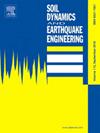Response of an elastic half-plane with an embedded circular cavity subject to a harmonic anti-plane shear wave: A comparison of methods
IF 4.2
2区 工程技术
Q1 ENGINEERING, GEOLOGICAL
引用次数: 0
Abstract
In this paper, we investigate the response of a cavity embedded in an elastic half-plane (2D) subjected to a harmonic SH wave. In previous work, the method of conformal mapping and the indirect boundary element method (indirect BEM) were employed to solve the 3D wave scattering from a cylindrical tunnel embedded in a half-space. Inaccurate results were obtained particularly at high frequencies (method of conformal mapping). Therefore, in this study we focus on a comparison of the two methods with the method of images, which serves as a benchmark solution. Through a systematic evaluation, we confirm that the two methods accurately work within the complete considered ranges of the dimensionless frequency and the embedded cavity depth. This suggests that representing the waves scattered from the free surface by cylindrical waves in the method of conformal mapping is the cause of the inaccuracies at high frequency in the 3D problem; the cylindrical waves are probably not able to fully capture all wave conversions taking place at the free surface. The presented results reveal significant effects of the system parameters on the responses. The system’s response curves display nearly equally spaced resonances, which is in line with those of the 1D shear layer subject to bedrock motion, while similar response curves for the 3D case do not have this feature.
求助全文
约1分钟内获得全文
求助全文
来源期刊

Soil Dynamics and Earthquake Engineering
工程技术-地球科学综合
CiteScore
7.50
自引率
15.00%
发文量
446
审稿时长
8 months
期刊介绍:
The journal aims to encourage and enhance the role of mechanics and other disciplines as they relate to earthquake engineering by providing opportunities for the publication of the work of applied mathematicians, engineers and other applied scientists involved in solving problems closely related to the field of earthquake engineering and geotechnical earthquake engineering.
Emphasis is placed on new concepts and techniques, but case histories will also be published if they enhance the presentation and understanding of new technical concepts.
 求助内容:
求助内容: 应助结果提醒方式:
应助结果提醒方式:


